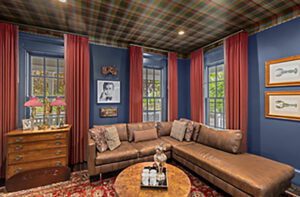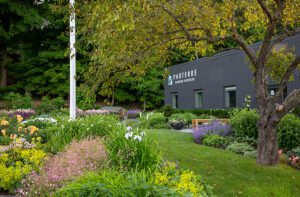Shope Reno Wharton Designs a Home Using Reclaimed Stone
January 10, 2024
A new house in southern Connecticut brings recycling to architectural heights.
Text by Gail Ravgiala Photography by Robert Benson
The rocky, rugged, wooded property in southern Connecticut presented a challenge for architect Michael O. McClung. “It was a lot of topography,” he says, and not much of the two and a half acres was conducive to siting the 5,600-square-foot house his clients had in mind. But where there is challenge, there is opportunity, and in the words of renowned Bauhaus architect Walter Gropius, “Limitation makes the creative mind inventive.”
McClung zeroed in on a small star-shaped spot atop a ledge where there is a lovely view of a pond on the adjacent golf course as the optimal location for the house. “The main living space is laid out along the ridge,” says McClung, a partner in the architecture firm Shope Reno Wharton. With a facade of stone reclaimed by mason Jeff Bojadzic from a demolished Bronx church, the house appears to rise organically from its rocky perch. White grout finishes the blocks of solid stone, making them feel light. “The masonry is stunning,” says McClung.
The homeowners, a businessman and his wife, a professional chef, wanted the interior to feel like a “modern barn,” says McClung, who worked closely with SRW project architect Jose Goncalves to create spaces that are both open and intimate. “The concept was to use natural elements,” McClung says, “and light was one of those elements.” Walls of glass in the form of steel-framed windows and doors brighten every room. “The sunlight in the house is a major participant.”
The house is laid out in two wings, one holding the entry, great room, kitchen, and two second-floor bedrooms, the other encompassing the primary suite and home office. The decor is casual, restful, and inviting. “I took my design cues from the church stone and wood finishes and the indoor-outdoor sensibilities throughout,” says interior designer Douglas Graneto of Douglas Graneto Design. “I never wanted the house to feel cold. We used warm tones and textures that complement the natural materials. The goal was to not overdo the house. We kept pulling back until we got it right.”
In the great room, cathedral ceilings lined with planks of white oak—acoustically spaced to absorb sound and minimize echo—bring a cocoon-like warmth to the light-filled combination living and dining space. The client/chef wanted the kitchen to be supremely functional, open to the dining area, accessible to the outdoor terrace, and welcoming to family and friends. Tucked behind the main kitchen area, the chef requested a more personal pantry and baking corner, complete with a version of legendary cook Julia Child’s signature wall display of favorite pots and pans. A sliding window above the sink serves as a pass-through for food and beverages to the much-used terrace, which is outfitted with a television, a U-shaped sofa for lounging, and a stone fireplace to take the chill off on cool nights.
To complete the connection between house and setting, landscape architect Keith Wagner of Wagner Hodgson Landscape Architecture continued the use of recycled church stone. “We used it for walls and steps as a way of extending the structure,” he says. “The landscaping is modest and subtle and lets the house and views dominate.” Referring to the entire design team, he says, “Getting the house to fit like it grew from the ledge was a task. But we achieved it.”
Project Team
Architecture: Shope Reno Wharton
Interior design: Douglas Graneto Design
Landscape design: Wagner Hodgson Landscape Architecture
Share
![NEH-Logo_Black[1] NEH-Logo_Black[1]](https://b2915716.smushcdn.com/2915716/wp-content/uploads/2022/08/NEH-Logo_Black1-300x162.jpg?lossy=1&strip=1&webp=1)

















You must be logged in to post a comment.